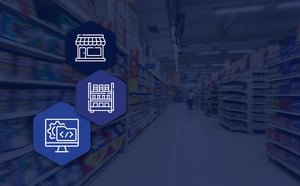Measuring success in retail merchandising might seem as straightforward as achieving high sales with even higher profit margins. Yet, delve a bit deeper, and the landscape reveals itself to be intricately layered. Each retailer must carve out a unique identity, not just through the types of merchandise offered but also through tailored retail merchandising strategies, outstanding customer service, and competitive pricing.
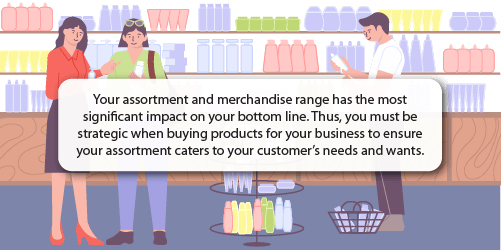
That also answers the question - Why? But it doesn't answer why you need to apply different retail merchandising techniques to each type of merchandise differently. There are various reasons, all of which we'll touch on in more detail. Each merchandise type caters to different shopping needs and behaviors, so you must treat each separately.
Of course, applying different retail merchandising techniques and tactics for each type of merchandise is the theoretical part. But the true challenge lies in its practical application. How do you present them? Our answer is specialist software. We'll also explain how you can use DotActiv software to create visually appealing shelves for various merchandise types.

What are the different types of merchandise?
Have you ever walked into a store and found essentials like milk and bread conveniently at the entrance, or noticed that Christmas decorations start popping up right as autumn leaves fall? It isn't by accident. It's the magic of understanding varied types of merchandise.
While there are many ways to classify merchandise - from price to lifecycle - we'll focus on classification by use in this article.
Staple or Basic merchandise
Staples or basic merchandise are essential products that consumers frequently purchase as part of their regular shopping routine. These items often have predictable sales patterns and exhibit consistent demand, with little influence from trends or seasons.
Examples of basic merchandise include bread, milk, eggs, rice, toothpaste, and other daily necessities. They're the backbone of grocery and convenience stores, ensuring customers return for their daily or weekly essentials.
Fashion merchandise
While staples remain constant, fashion merchandise dances to the rhythm of trends. It's about apparel, accessories, and everything in vogue. Its popularity might peak one season and wane the next, depending on fashion cycles and cultural shifts.
Fashion merchandise examples include seasonal clothing, trendy footwear, accessories, designer labels or branded apparel, eyewear, and special occasion wear.
Seasonal merchandise
As seasons change, so does the demand for certain products. Seasonal merchandise shines brightest during specific times of the year. Their sales peak during these periods and can drop significantly or even become nonexistent outside of these times.
Examples of seasonal merchandise include holiday-related products such as Christmas decorations, Halloween costumes, Easter eggs, and Fourth of July fireworks; weather-dependent products such as winter gear and summer items; seasonal food such as fruit and vegetables; and sporting or activity-based products such as ski equipment or gardening tools.
Convenience merchandise
When you're in a rush or looking for a quick pick-me-up, convenience merchandise is there to catch your eye. Easily accessible, these are the items often picked up impulsively.
Typical examples of convenience merchandise include snack foods, beverages, newspapers and magazines, personal care items like lip balm and hand sanitizer, chewing gum, batteries, and ready-to-eat meals.
Shopping merchandise
Imagine you're contemplating buying a new laptop. You weigh the pros and cons, consider various brands, and might even hop from one store to another (or website to website) to get the best deal. That's shopping merchandise for you - items that demand thought and often a deeper dive into your wallet.
Examples of shopping merchandise include electronics such as televisions, laptops, and smartphones; household goods such as furniture, major appliances, and home decor; automobiles; and specialist equipment like musical instruments and photography gear. It's a realm where customers engage deeply before purchasing, ensuring they get the best value and quality.
Specialty merchandise
Specialty merchandise refers to those items that attract a dedicated fanbase. People seek them out, often showing unwavering loyalty to a particular brand or item. They're the unique, the luxurious, the specialized.
Examples of specialty merchandise include high-end brands such as luxury watches and designer handbags; unique products such as collectible items and art pieces; specialized equipment such as high-end camera lenses or specialized musical instruments; and specific brands or items with a strong loyalty such as Apple for tech enthusiasts or specialty coffee brands for aficionados.

Why is the critical to merchandise products differently?
Understanding each type of merchandise is just the beginning. Tailoring your retail merchandising approach to the nuances of each category is crucial to resonate with shoppers' intentions and behaviors, allowing you to optimize sales and enhance the overall shopping experience.
Staple or Basic merchandise
Efficiency for trust: For staple goods, seamless shopping experiences are paramount. Frequent consumer purchases mean retailers must ensure swift restocking. The consistent availability of essentials like bread or milk builds trust and assures customers they can rely on you.
Consistency for comfort: Avoid turning the shopping for daily essentials into a treasure hunt. By consistently positioning these products in predictable spots, customers enjoy a seamless shopping journey - a subtle invitation for them to return.
Fashion merchandise
Trend spotlights for relevance: The ever-evolving world of fashion demands retailers to be on their toes. By showcasing the latest styles and pieces prominently, you signal your store's dedication to offering what's currently in vogue, attracting fashion-conscious consumers.
Adaptability for engagement: To retain customer interest, it's essential to regularly refresh offerings. Quickly adapting to and rotating between emerging trends or seasons ensures that displays remain fresh and relevant, making customers view the store as a hub of the latest fashion insights.
Seasonal merchandise
Anticipation for preparedness: Be the early bird. Displaying seasonal items just before the season kicks in caters to early shoppers eager to get ahead. It signals that your store is a proactive destination.
Visibility for maximization: Given the fleeting nature of seasonal items, prime store locations are a must. Central, attention-grabbing setups leverage the short selling window and inspire impulsive purchases.
Convenience merchandise
Grab-and-go for spontaneity: Last-minute decisions dominate the world of convenience items. Strategically placing these near high-traffic areas, especially checkouts, harnesses the power of impulse, driving incremental sales.
Clarity for instant recognition: For convenience items, being easily recognizable is key. Streamlined, clutter-free displays with clear labeling emphasize the product's grab-and-go nature.
Shopping merchandise
Informed choices for confidence: Customers appreciate clarity, given the heftier price tags of shopping merchandise. By grouping related items or showcasing comparison charts, you simplify their decision-making and boost their purchase confidence.
Engagement for conversion: Creating an immersive shopping environment, whether via interactive displays, product trials, or well-informed staff, transforms mere browsing into definitive purchases. Without this touch, customers might feel lost or underserved.
Specialty merchandise
Distinctive showcase for allure: Specialty items are more than just products; they’re experiences or statements. Presenting them uniquely, perhaps with bespoke displays, accentuates their exclusivity and desirability.
Narrative for connection: Specialty items often carry rich backstories or artisanal craftsmanship. Sharing these stories fosters a deep emotional connection with customers and underscores the product's worth, justifying its premium and bolstering sales.

How to present types of merchandise using DotActiv software
DotActiv software offers a suite of retail and store fixtures to showcase your types of merchandise effectively. Below, we show how you can present the different merchandise types in-store.
Staple or Basic merchandise
The two primary fixture types in the DotActiv software used for staple merchandise are pegboards and shelves.
We use pegboards for merchandise that’s best displayed hanging, for example, sweets. With DotActiv, you can customize the height, width, and depth of your pegboards and the thickness and length of your pegs.
Generally, we use shelves for merchandise that can stand independently and without support, for example, boxed cookies. A shelf fixture is customizable to accommodate the thickness, width, and depth of the shelf fixtures in your stores.
But what about staple merchandise that can't stand independently and be displayed hanging?
You can add shelf dividers and grills to keep your merchandise in place and prevent it from falling off the shelf. Considering the size of the products, you can change the width, height, and spacing of the dividers and the height of the grills.
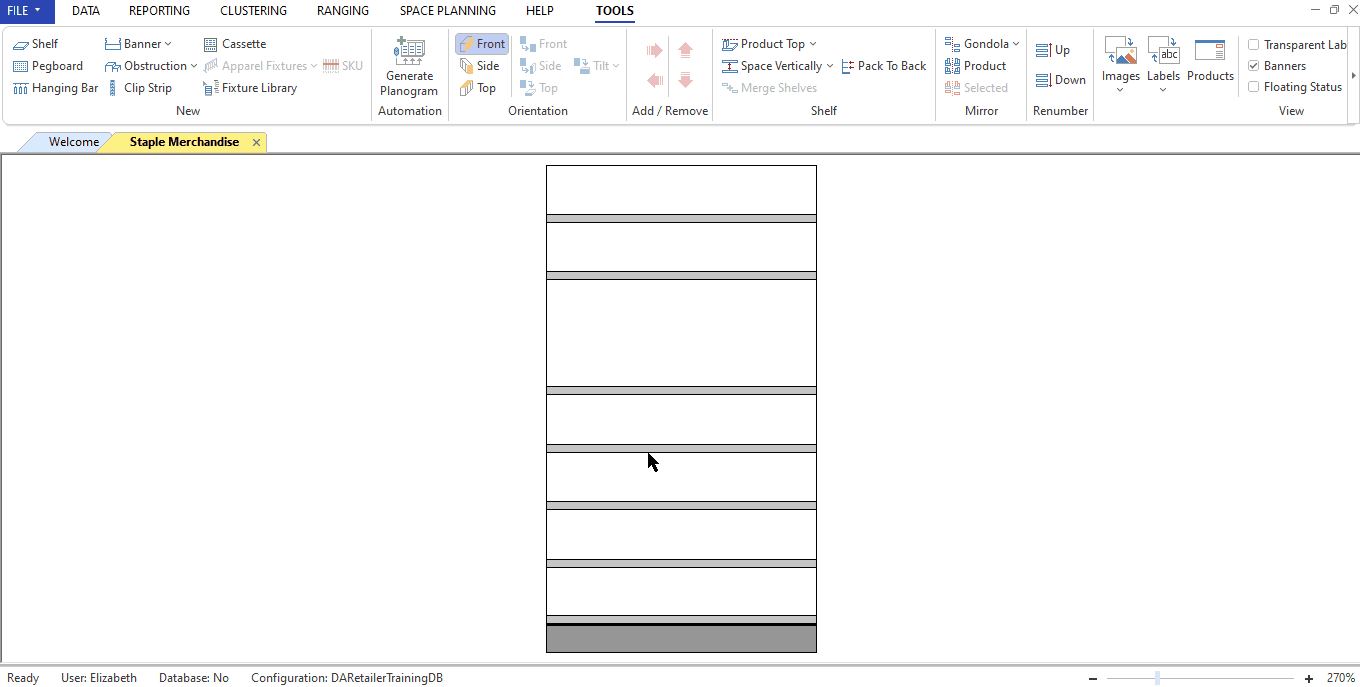
But what about staple merchandise that is unable to stand independently and be displayed hanging?
You can add shelf dividers and grills to keep your merchandise in place and prevent it from falling off the shelf. Considering the size of the products, you can change the width, height, and spacing of the dividers and the height of the grills.
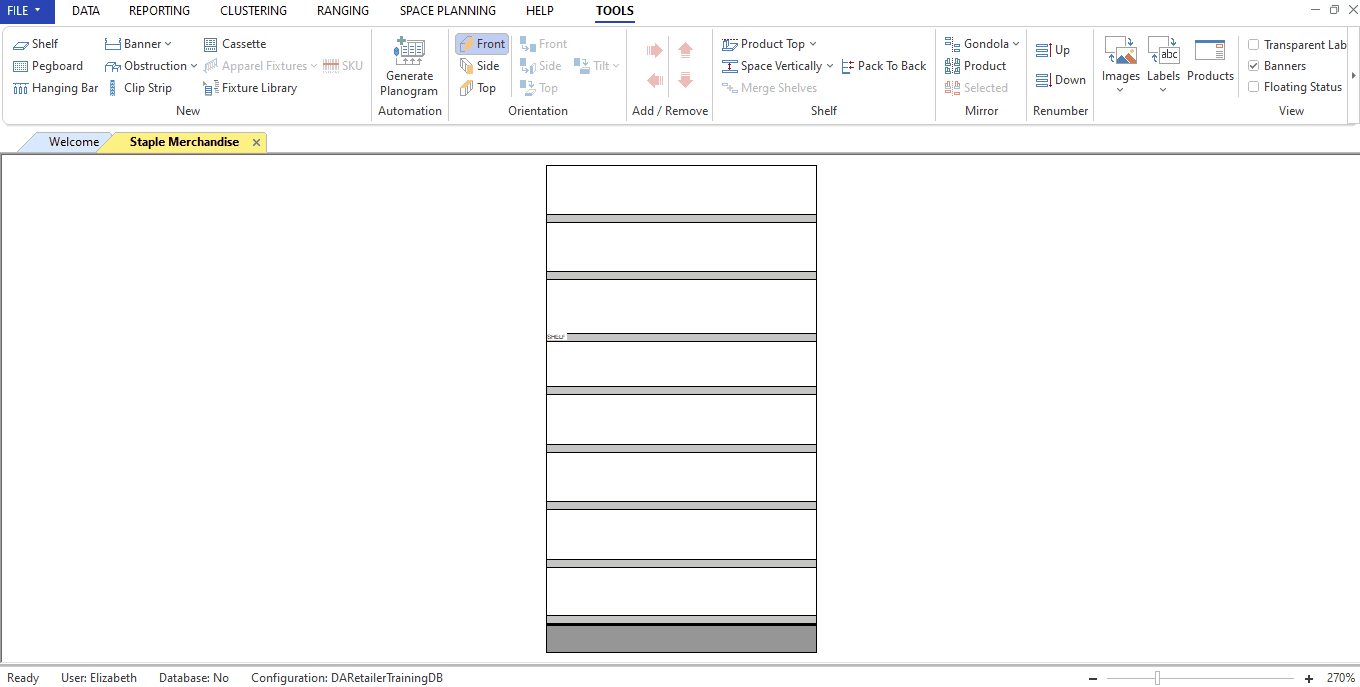
Whether you are using shelves to display your staple types of merchandise or pegboards, there are a few fundamentals to consider in retail merchandising.
- Merchandise your top performer at eye level to avoid frustrated shoppers who can’t find what they are looking for.
- Next to the top performer or brand leader, merchandise your house brand for product exposure.
- Define your retail merchandising flow according to shopper behavior, e.g., brand loyalists want all products in a brand together regardless of product type, and price-sensitive shoppers prefer merchandise types with a similar price point together.
- Avoid cluttered displays (and overwhelmed customers) by merchandising from smallest to largest, vertically and horizontally.
Merchandising from small to large is not the only way to declutter your displays. Evenly-spaced shelves also increase the visual appeal of your displays.
Here is how you enhance your display by ensuring there is balance.
Step 1: Select all your fixtures,
Step 2: Click ‘Space Vertically’, and
Step 3: Click ‘Only Selected’.
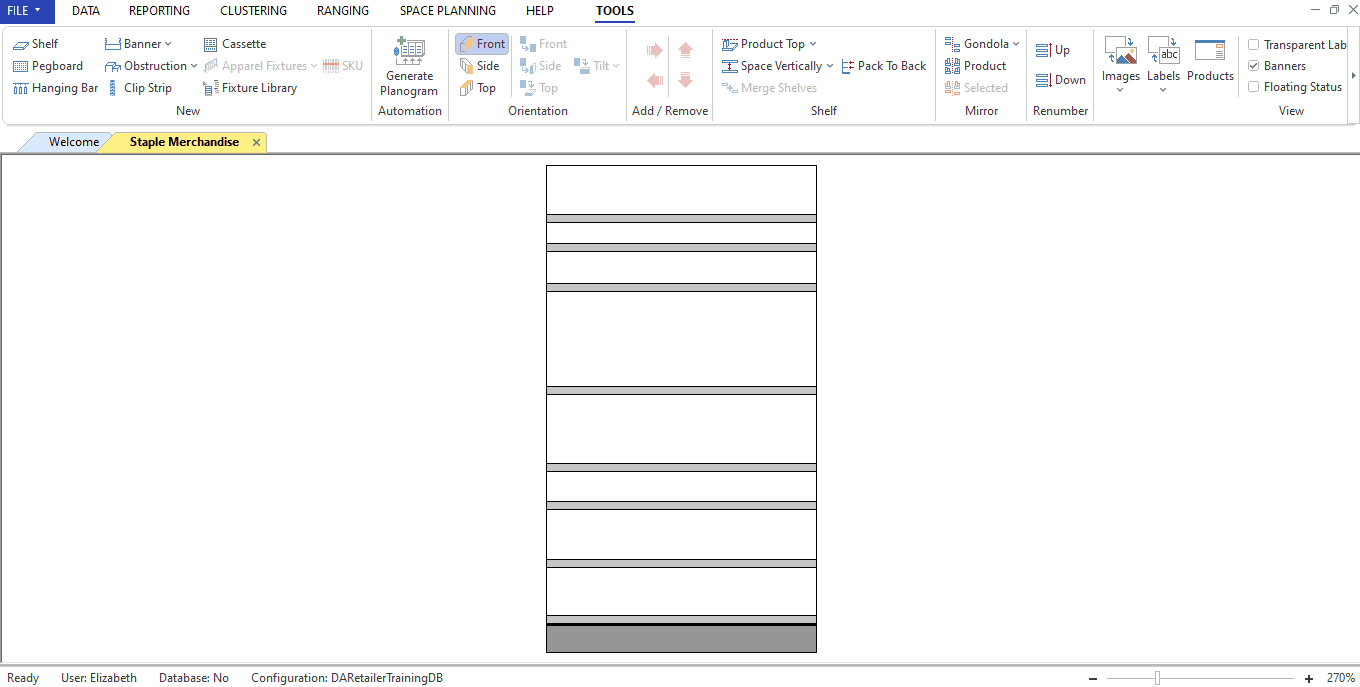
Fashion merchandise
DotActiv’s apparel containers are ideal for displaying types of fashion merchandise. Depending on the display you want to create, you can add five different apparel fixtures to your apparel container.
Single Bar
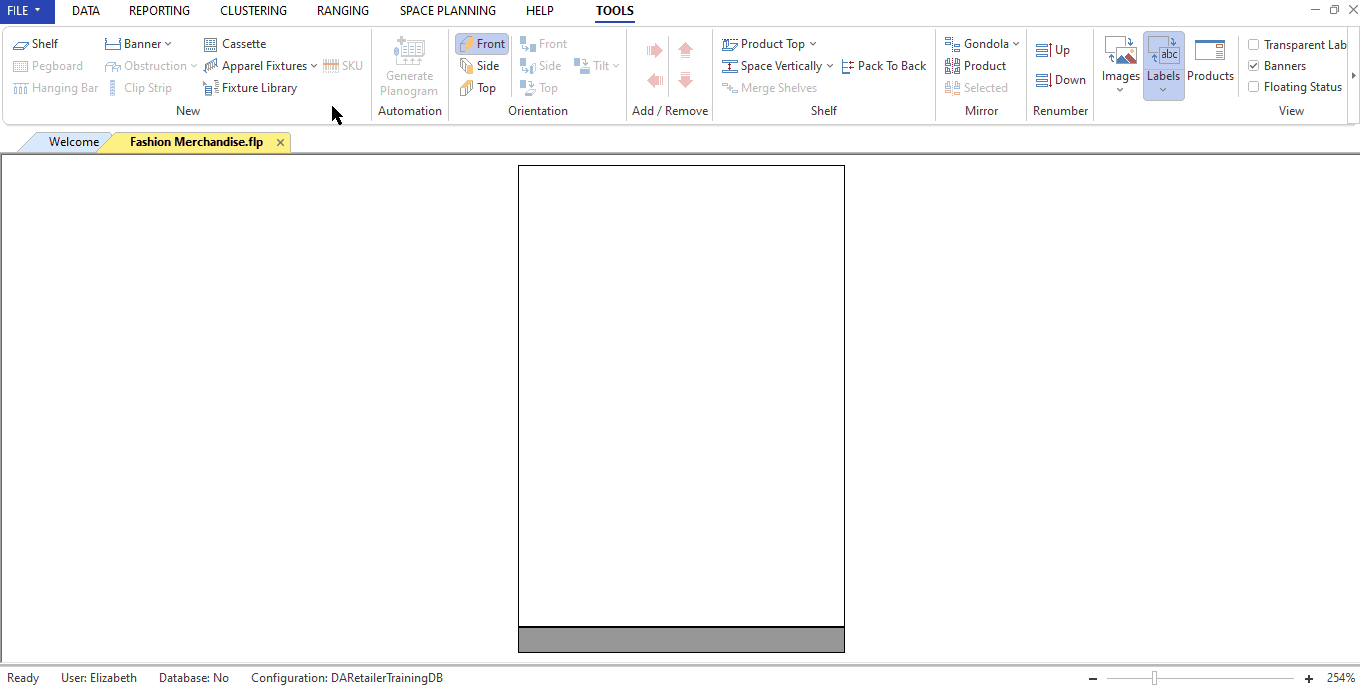
Double Bar
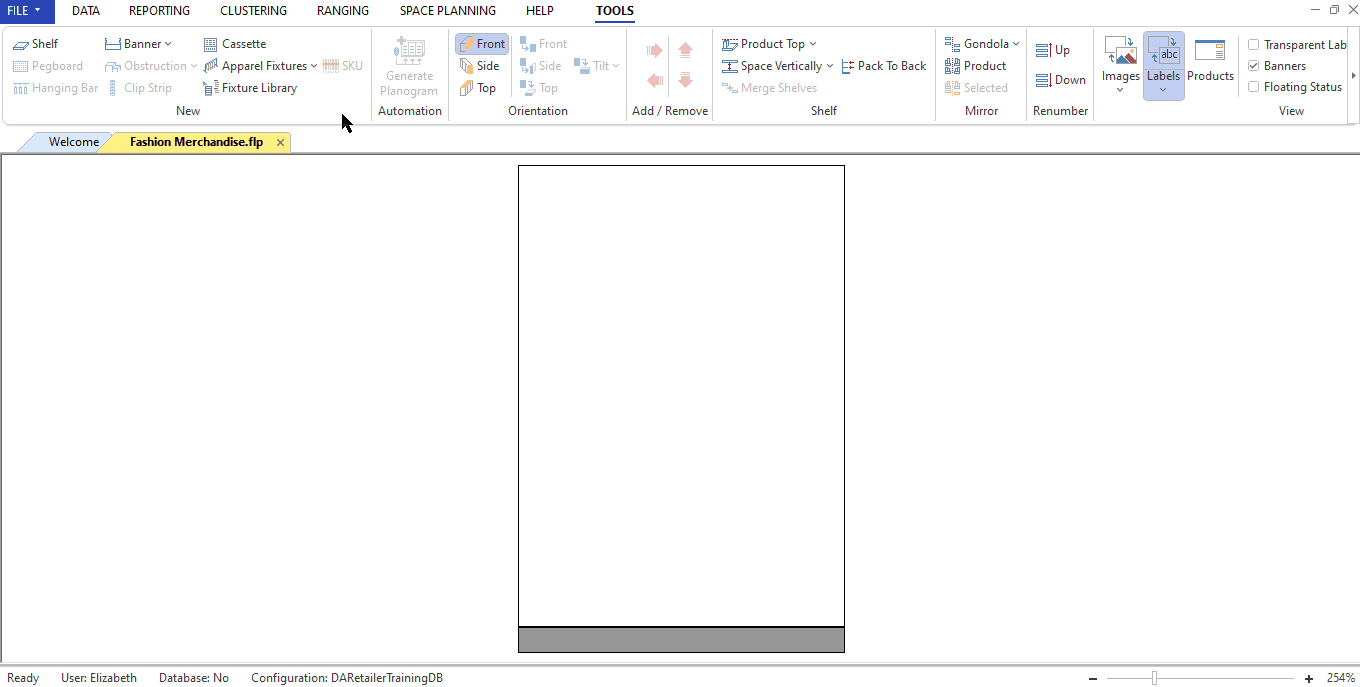
Four Bar
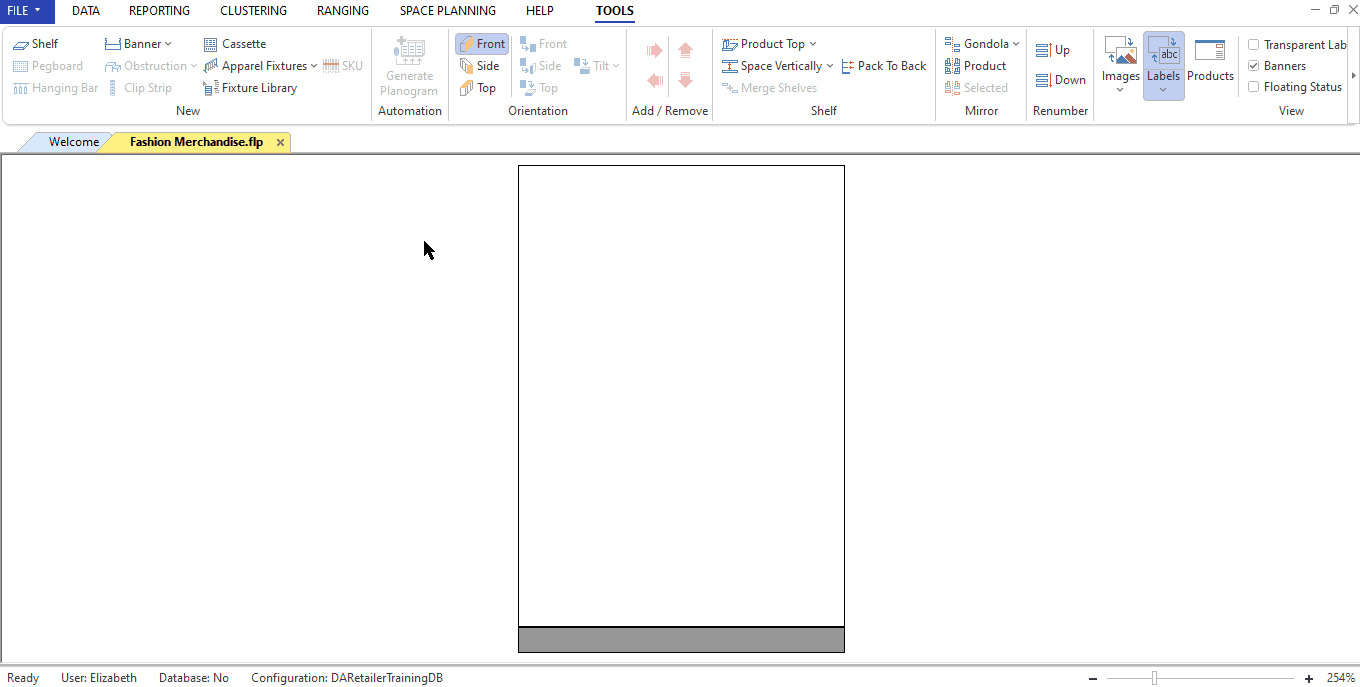
Circular Bar
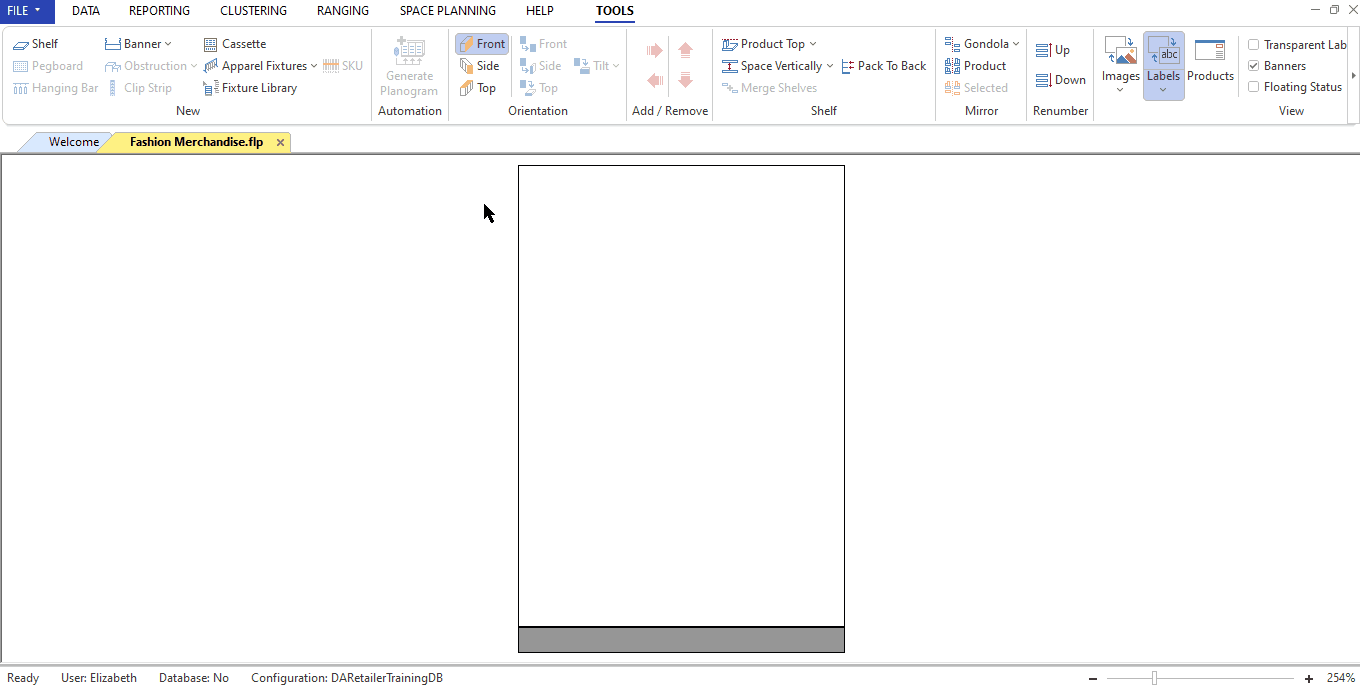
Table
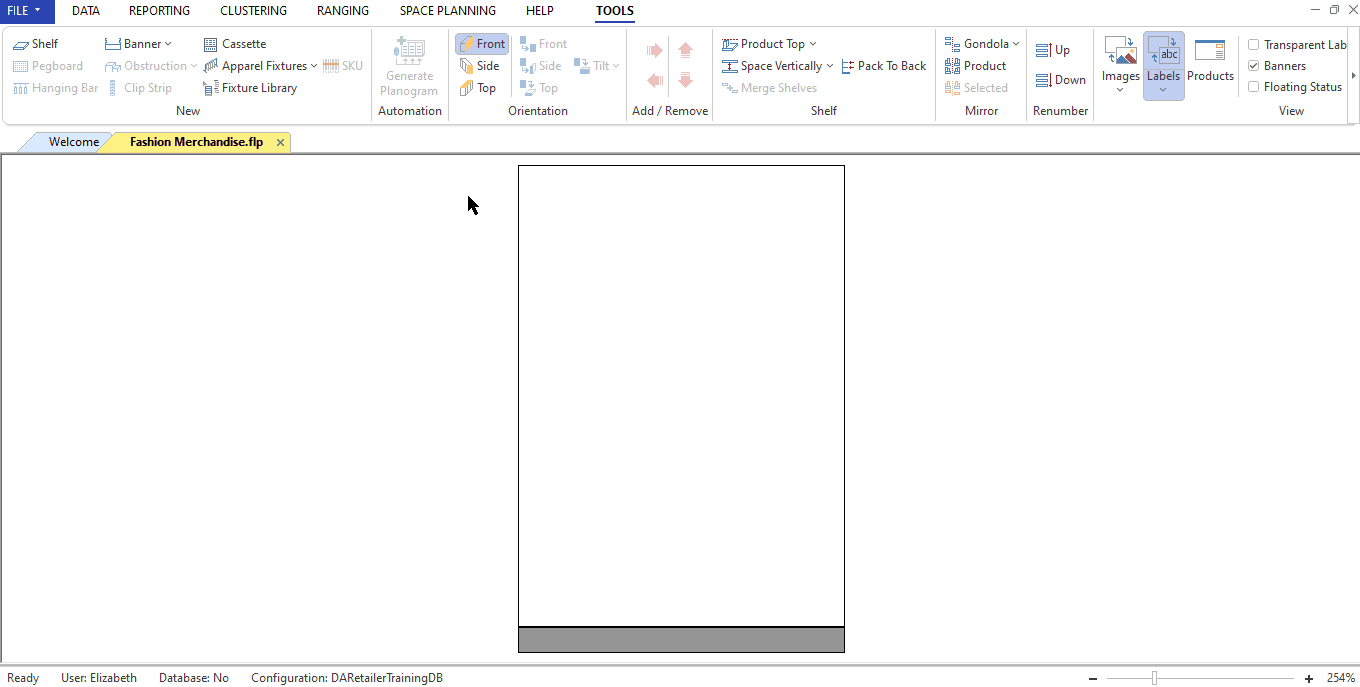
Unlike other types of merchandise like staple merchandise, fashion merchandise requires focusing more on a creative and visually appealing display than a data-driven display.
You can create themed displays by cross-merchandising complementary items together. For example, design displays with complementary tops, bottoms, shoes, and accessories to encourage consumers to purchase the entire outfit.
Be aware of which items to hang or fold in order to avoid damage. For example, fold delicate knitwear as it can easily stretch if hung.
Also, consider the season because consumers might not shop for knitwear, cardigans, vests, or jerseys in summer.
Like seasonal merchandise displays, you can add banners to attract consumers.
Adding banners to fashion merchandise displays reinforces the theme and can generate excitement. For example, adding a banner of a styled photoshoot where friends play volleyball on a beach next to a swimwear display might influence consumers to buy new swimwear for the holiday season.
Seasonal merchandise
Conditional to the different types of seasonal merchandise, you can also use fixture types like shelves and pegboards to create your displays.
And even though macro space planning also comes into play when displaying staple merchandise, it is crucial for successful seasonal merchandise displays.
When seasonal merchandise is in season, you want to drive sales as much as possible. One way to do this is to ensure your seasonal merchandise has high visibility in your store by placing it in the storefront, where there is high foot traffic.
Here, you can cross-merchandise and bundle your seasonal products with complementary products. For example, grouping sunscreen, beach towels, and flip-flops to create value and convenience for your customer.
Essentially, you want to create a sense of excitement using colors, lighting, props, and graphics that match the season and theme.
With DotActiv software, you can use the banner function to add promotional banners to elevate your themed promotions and create excitement amongst your consumers, enhancing the retail merchandising of seasonal and fashion merchandise types.
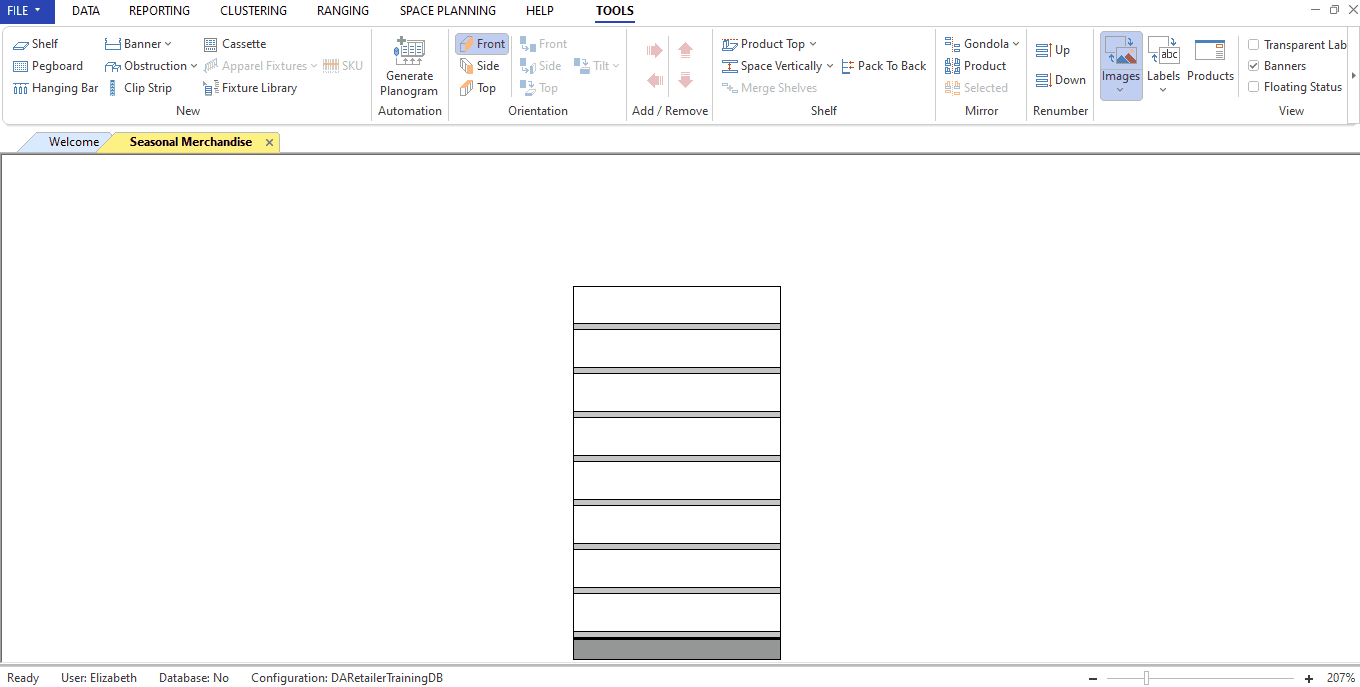
Convenience merchandise
If you want to retail merchandise convenience items, or types of convenience merchandise, in-store, the best retail fixtures in DotActiv software are gondola shelving, refrigerated displays, and end caps.
Why the emphasis on simplicity? Convenience shoppers are typically in a rush, seeking quick, hassle-free purchases. Therefore, your store fixtures should prioritize direct access and clear visibility to encourage swift decision-making.
DotActiv software helps optimize your shelf layout to ensure you display any products that fall under convenience merchandise in an organized manner.
We advise you to rotate your stock frequently, perhaps once a quarter. Also, combine regularly purchased items with newly introduced ones to provide more exposure to your new products.
With DotActiv software, you can strategize for seasonal shifts, promotions, and the introduction of new products. Leveraging its analytics, you can ensure that your merchandise continuously aligns with evolving customer preferences.
Shopping merchandise
Types of shopping merchandise stand out from other categories due to its diverse range and the need for customers to make more informed choices. This type of merchandise often demands a specific retail merchandising display strategy, one that DotActiv's software can help streamline.
Within DotActiv, you can utilize planograms or gondola layouts to visualize and strategize the presentation of these items. These don't just aid in placing products but can also help you determine the optimal positioning for interactive displays and highlight sections that can benefit from special fixtures.
When setting up your retail space, consider pairing traditional fixtures such as gondola shelving with shelving units, hanging fixtures, and end caps. Each of these displays shopping merchandise in an attractive and informative way.
Understanding your target demographic is also paramount. Using DotActiv, you can gain insights into their preferences, helping you design layouts that cater directly to their shopping habits.
For example, in the electronics section, group complementary items next to each other. You can set up interactive stations for products that customers typically want to try before buying, like high-end gadgets. Here, DotActiv can guide you on positioning these stations in high-engagement areas, ensuring maximum visibility and customer interaction.
Specialty merchandise
For high-end items, the best displays are display cases, as you can highlight its exclusivity. In some cases, you can use a planogram to merchandise the flow placement of your products but then add a frame to display the case.
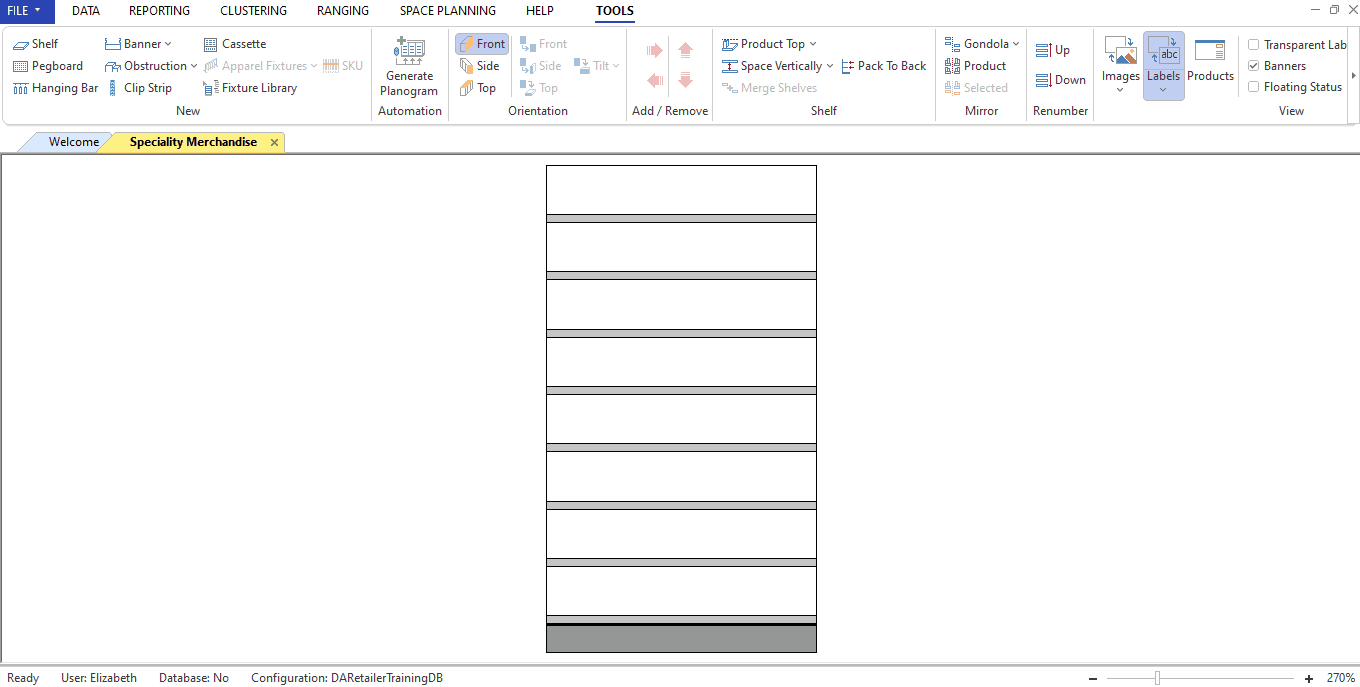
We’d also recommend using freestanding displays, custom props and fixtures, and floating shelves. Fortunately, DotActiv software allows you to create customized planograms for specialty merchandise.
As for best practices, it comes back to understanding your target market and your specialty. Knowing your target market and their aspirations and desires will help you tailor your displays. Whether it's a limited-edition piece or artisanal craft, its presentation should resonate with your intended audience.
With DotActiv, you can fine-tune these displays to evoke the emotions that prompt purchases.
Conclusion
Navigating the world of retail merchandising can be intricate, but with the right tools, it becomes easy - a blend of science and aesthetics that can elevate the shopping experience. DotActiv software offers a dynamic approach, catering to every merchandise type.
Ready to transform your space? Try a free 14-day trial of DotActiv Lite.


